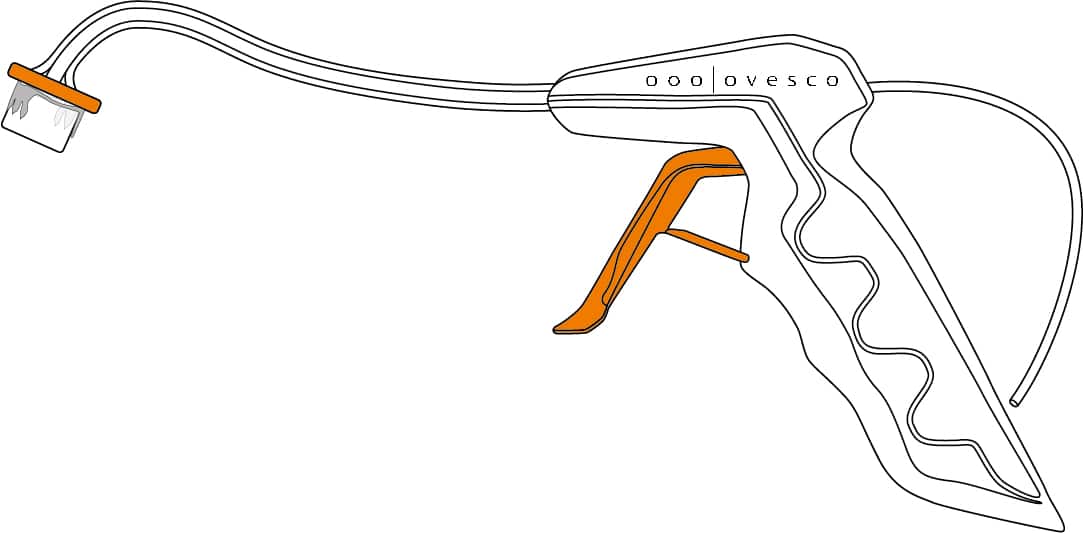
OTSC® Proctology is a sphincter-preserving surgical procedure for the effective closure of anorectal fistulas.
+49 (0) 7071 96528 160
service@ovesco.com

+49 (0) 7071 96528 160
service@ovesco.com
Instrument for proctology for compression of tissue in the anal canal and rectum, for treating wall lesions or haemostasis.
OTSC® Proctology consists of the applicator with a pre-mounted clip as well as a pre-set inserted thread retriever inside the working channel.

The applicator is inserted transanally under direct vision. By pulling the trigger, the clip is released and pushed into the tissue from the applicator cap.
To facilitate the application, generally U-shaped sutures are placed at the target site. They can be pulled through the working channel by means of the pre-set thread retriever. After successful application of the clip, the sutures can be removed again. Alternatively, the OTSC® Proctology Anchor can be used as guidance and positioning aid.
All OTSC® Proctology products are for single use only.
| Instrument with preloaded Proctology Clip 14t (A) | 11 mm clip width (a) |
| Deployment ring (B) | Ø 23 mm |
| Application cap (C) | 14.8 mm cap depth, outer diameter 23 mm (b) |
| Release mechanism (D) | |
| Safety lock (D1) | |
| Deployment trigger (D2) | |
| Working channel (E) | Ø 2.5 mm, length 136 mm |
| Thread retriever (F) | |
| Items per package | 1 |
| Reference number | 200.60 |
Initially, it is advisable to manage the pre-treatment of the fistula before surgery like in other therapeutic procedures.
Step 1: Fistula is probed and seton inserted
Before application of the OTSC® Proctology it must be ensured that the inflammatory phase of the fistula has subsided, i.e. no abscess or other major infection is present along the tract of the fistula. As for preparation in other therapies this can be achieved with the placement of a seton drainage for approximately two to three months before clip application. The period of time is dependent on the respective findings and needs to be assessed by the respective physician.
Step 2: Excision of a circular area of anoderm around the fistula opening
To avoid pain from the clip application on the sensitive anoderm, it is excised circularly around the internal opening of the fistula with a diameter of approximately two centimeters. The clip is then applied right onto the sphincter muscle.
Step 3: Debridement and removal of granulation tissue
Before the OTSC® Proctology application, the special Fistula Brush can be used to remove granulation tissue, epithelium and debris lining the fistula tract. To facilitate introduction of the brush into the outer fistula orifice the drainage seton is attached to the eyelet of the brush. If no seton is present, the brush can alternatively be inserted directly and cautiously with its round end (probing olive). After debridement of the fistula tract by alternating movements of the brush, the tract is rinsed with an appropriate rinsing solution (e.g. saline). The shaft of the brush can be left positioned in the fistula tract in order to indicate the internal opening of the fistula.
Step 4: Precise alignment with sutures or OTSC® Proctology Anchor
The first step of OTSC® Proctology placement is the precise alignment between the applicator cap and the inner fistula orifice. The area of the inner fistula orifice has to be pulled into the cap (if possible) or has to be at least firmly in contact with the cap of the OTSC® Proctology applicator.
The area around the internal fistula opening is stitched cross-like with two resorbable U-shaped threads, placed through the sphincter muscle. This approach ensures the centered tissue mobilization into or onto the application cap of the OTSC® Proctology applicator.
In case the fistula cannot be reached with sutures, the fistula can be grasped and pulled using the OTSC® Proctology Anchor which can be inserted through the working channel of the instrument.
Step 6: Correct positioning of OTSC® Proctology
By holding the sutures under slight tension, the OTSC® Proctology applicator is advanced towards the internal opening of the fistula. The sutures serve as guidance on which the applicator is advanced centrally to the internal opening of the fistula tract. The OTSC® Proctology applicator has to be aligned parallelly to the axis of the anal canal to achieve an anatomically correct positioning of the clip shape within the anorectum.
Step 7: OTSC® Proctology Clip Application
The applicator cap is centered and placed on the tissue around the fistula opening with stable contact. Misplacement or dislocation of the applicator should to be avoided, in order to ensure a correct placement on the fistula opening. After folding back the safety lock, the deployment trigger of the applicator is pressed and the deployment ring pushes the clip off the applicator cap.
Remark
After closing the inner orifice of the fistula, drainage of the fistula tract and/or abscess is mandatory in order to achieve the best possible result. A conically shaped excision of the outer orifice should be performed. This might be followed by placing gauze or similar within the fistula tract to hinder the surrounding skin to accomplish closure of the fistula followed by abscess formation and fistula relapse.
